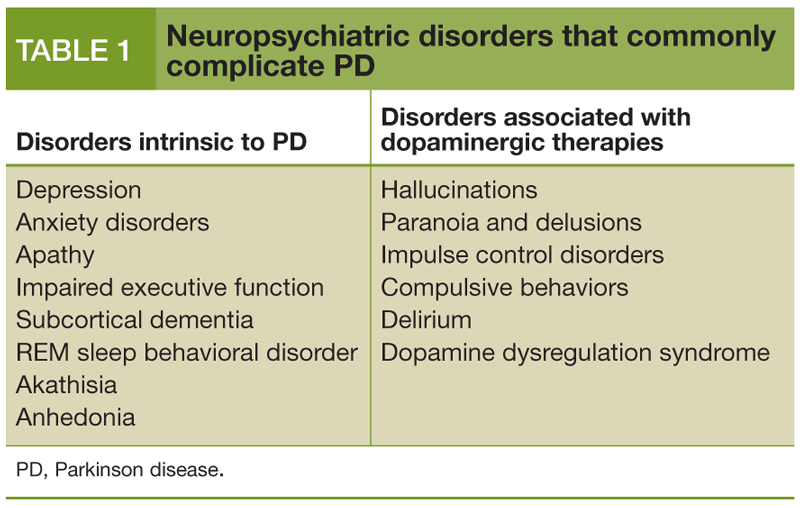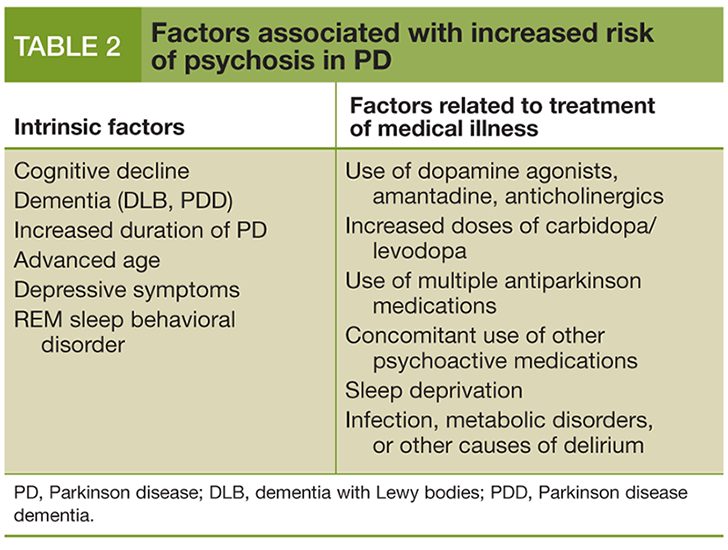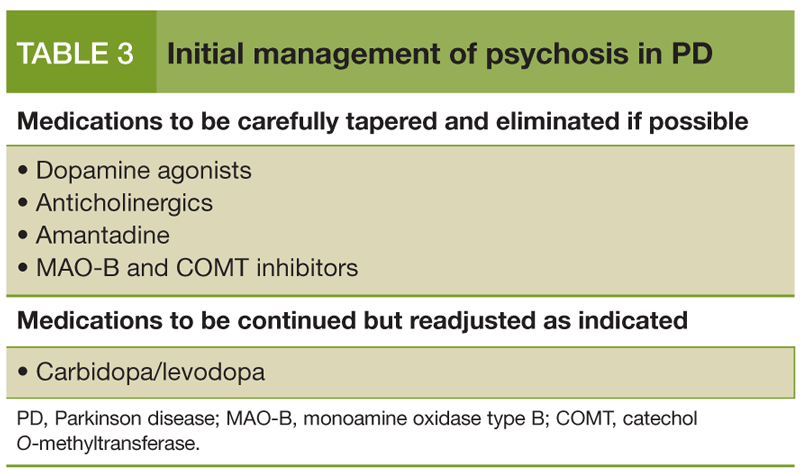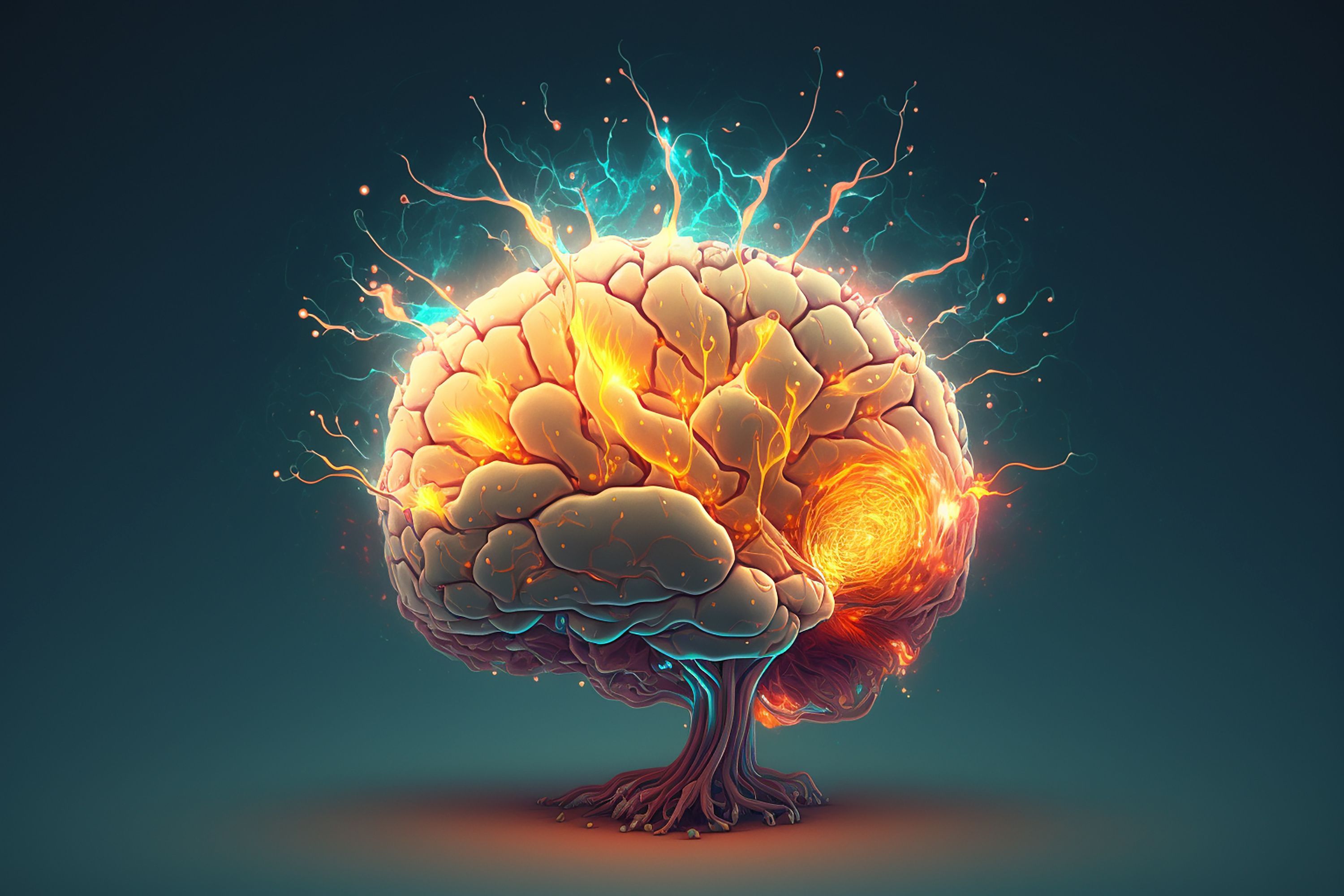Publication
Article
Psychiatric Times
Management of Psychosis in Parkinson Disease
Author(s):
For some patients with Parkinson disease, the neuropsychiatric complications are a greater source of morbidity than the motor dysfunction. This article focuses on the management of psychosis in Parkinson disease.
Table 1: Neuropsychiatric disorders that commonly complicate PD

Table 2: Factors associated with increased risk of psychosis in PD

Table 3: Initial management of psychosis in PD

The diagnosis of Parkinson disease (PD) is based on the observation of a constellation of motor abnormalities (bradykinesia, tremor at rest, cogwheel rigidity, postural instability) and the exclusion of other secondary causes of parkinsonism. The disease is classified as a “movement disorder,” but for many patients with PD the motor problems are only the tip of the iceberg. A host of neuropsychiatric disorders are intrinsic to PD or occur as a complication of the dopaminergic therapies (dopamine agonists, levodopa) or anticholinergic medications used to treat the motor symptoms (Table 1). For some patients with PD, the neuropsychiatric complications are a greater source of morbidity than the motor dysfunction.1,2
The neuropsychiatric disorders associated with dopaminergic therapies are important to recognize, because they are at least partially iatrogenic and can often be successfully managed by adjustment of the patient’s PD medications. This article focuses on the management of psychosis in PD-a problem with significant morbidity. Psychosis in PD and Parkinson-related disorders (eg, dementia with Lewy bodies, Parkinson disease dementia) is an independent predictor for the need for institutionalization and increased mortality.
Susceptibility to psychosis
The underlying susceptibility to psychosis is strongly related to the patient’s mental status. PD patients without cognitive decline who are not receiving medications to palliate their motor symptoms seldom experience delusions or hallucinations. However, mild psychotic symptoms (eg, visual illusions [a distorted sensory perception of a real stimulus], benign visual hallucinations/sense of presence [sense that someone is nearby when there is no one], or passage hallucinations [fleeting visual imagery in peripheral vision]) occur in approximately 10% to 20% of nondemented patients with PD who receive dopaminergic treatments.3
Hallucinations are more likely to appear in situations such as at twilight or evening (sundowning), where there is little background stimulation, or when the patient is alone in a quiet room. Dopamine agonists are more likely to provoke hallucinations than is carbidopa/levodopa. Psychosis with hallucinations and delusions has been reported in as many as 20% of nondemented patients who receive medications for PD (Table 2).4,5
Conversely, patients with both parkinsonism and dementia commonly experience spontaneous visual hallucinations, delusions, and paranoia even in the absence of medications for the motor dysfunction. The introduction of dopaminergic therapies frequently triggers or exacerbates the underlying propensity to psychosis in patients who have dementia with Lewy bodies or Parkinson disease dementia.6
Patients with PD and their caregivers should be regularly questioned about the presence of hallucinations or abnormal ideas. Family members are often surprised to learn that their loved one experiences visual hallucinations, because many patients with PD are reluctant to divulge this information unless specifically asked, for fear of seeming crazy. Screening patients with PD and their caregivers for evidence of impulse control disorders, such as excessive gambling, abnormal sexual interests, and profligate spending behaviors, is also important. Impulse control disorders generally remain undetected unless specifically and assiduously sought by an astute clinician. Psychosis and impulse control disorders are common psychiatric complications of dopaminergic therapies that can have serious consequences if undiagnosed or untreated.
Although benign hallucinations/sense of presence do not inevitably evolve into severe hallucinations or frank psychosis (hallucinations, delusions), the presence of this phenomenon in patients with PD who are otherwise doing well should warn clinicians to be extra cautious and vigilant when increasing dopaminergic dosage or adding new medications.
The hallucinatory experiences in PD become increasingly vivid and frightening as the symptoms evolve into psychosis. Delusions of spousal infidelity, suspicions of harmful plots, and accusations of financial impropriety are a common triad encountered in patients with psychosis accompanying parkinsonian disorders. Psychotic symptoms can occur early after starting treatment for PD, although much less frequently than in the later stages of the disease.4,5
Pros and cons of pharmacological treatment
Anticholinergic medications (eg, trihexyphenidyl, benztropine) and dopamine agonists (eg, pramipexole, ropinirole, rotigotine) are more likely to trigger hallucinations and psychosis than is carbidopa/levodopa. The risk of psychosis varies with the dose in a somewhat unpredictable fashion. Some patients (particularly those with dementia) have an exquisite sensitivity, and symptoms develop with very low dosages. Others tolerate initial treatment well, but psychosis develops as dosages are escalated. Combinations of antiparkinson medications and the concomitant use of other psychoactive medications (eg, narcotic analgesics, muscle relaxants, benzodiazepines, anticholinergics) greatly enhance the risk of psychosis and delirium.
Carbidopa/levodopa is the most effective (and least expensive) medication for managing the motor symptoms of PD. Virtually all patients with PD will eventually require carbidopa/levodopa therapy to palliate their motor symptoms during the course of the disease. There is no compelling reason to use multiple medications when the motor symptoms can be successfully managed with carbidopa/levodopa monotherapy.
Most patients with PD do not need dopamine agonists, anticholinergic agents, amantadine, and other adjunctive agents such as monoamine oxidase type B (MAO-B) inhibitors, and catechol O-methyltransferase (COMT) inhibitors. These drugs increase the risk of neuropsychiatric adverse effects and should particularly be avoided in patients with dementia with Lewy bodies or Parkinson disease dementia, who already have an underlying propensity to hallucinations and psychosis.7
Brain cholinergic neuron function is more impaired in patients with dementia with Lewy bodies or Parkinson disease dementia than in those with Alzheimer disease. The anticholinesterase drugs rivastigmine and donepezil modestly enhance cognition in some patients. Findings suggest that the anticholinesterase medications palliate mild hallucinations and might reduce the risk of frank psychosis.8,9
Fluctuating motor symptom responses
As PD progresses over the years, levodopa remains effective, but unfortunately the duration of benefit becomes shorter. Thus, patients who have had PD for several years commonly develop motor fluctuations, where for part of the day their motor symptoms are relatively palliated; and at other times, when the medication effect is diminished or wears off, there is unpleasant immobility, stiffness, and tremor.
Initially, motor fluctuations are noticed at the end of the carbidopa/levodopa dosing period and resolve 30 to 60 minutes after the subsequent dose. However, as time goes by, the periods of lack of benefit become more frequent and less predictable. In addition to classic parkinsonian motor symptoms, these “off” periods can be accompanied by dystonia, severe pain, anxiety, and considerable emotional distress.
Determining the appropriate time interval between doses of carbidopa/levodopa and taking the medication on an empty stomach (to ensure optimal absorption and availability) is crucial in patients with PD with motor fluctuations. Nevertheless, many patients with PD with fluctuating responses cannot reliably predict when they will be “on” or “off”; this uncertainty leads to significant disability and withdrawal from normal social interactions.
When managing a patient with PD who has marked motor fluctuations, clinicians often use combinations (eg, carbidopa/levodopa plus dopamine agonists, amantadine, COMT inhibitors, MAO-B inhibitors) and higher doses of medications. This approach is often beneficial. However, escalation of levodopa doses combined with adjunctive agents to control motor fluctuations commonly leads to adverse effects, including intolerable dyskinesias, dopamine dysregulation syndrome, impulsive control disorders, or psychosis.1
The management of psychosis in PD with dementia is challenging (Table 3). In these patients, an attempt should be made to taper the use of combination therapy with dopamine agonists, anticholinergics, amantadine, MAO-B inhibitors, and COMT inhibitors.10
CASE VIGNETTE
A tremor and stiffness develop in the left leg of a 49-year-old woman with a past history of anxiety and panic attacks; the diagnosis is PD. She has no history of neuroleptic use, toxin exposure, or other secondary causes of parkinsonism. She is treated with carbidopa/levodopa, entacapone, and clonazepam, and she does well for several years. Five years after the onset of PD, a death in the family triggers depression. Her motor symptoms worsen during this period, and a dopamine agonist (ropinirole) and selegiline are added.
Over the next year, her personality changes and she becomes increasingly irritable and begins to exhibit strange behaviors; she becomes delusional, falsely accusing her husband of infidelity. She becomes sexually promiscuous and begins to spend money frivolously. She separates from her husband. She is seen by a psychiatrist and is briefly hospitalized. She receives paroxetine, clonazepam, lithium, and risperidone in addition to her usual PD medications. Her tremors and stiffness worsen. The treating physician increases the ropinirole dosage from 6 mg to 12 mg daily, and eventually the risperidone is stopped. On discharge she goes to live with her son.
The patient is referred for a second neurological opinion; the diagnosis is psychosis and impulse control disorders, which are a consequence of the dopaminergic therapies used to treat the PD. Entacapone and selegiline are discontinued; ropinirole is gradually tapered and discontinued. The patient is treated with carbidopa/levodopa 25 mg/100 mg before meals and at bedtime, which controls the motor symptoms. Quetiapine 25 mg at bedtime is added, and she continues on clonazepam 0.5 mg 3 times daily. Over the ensuing 9 months, the hallucinations and delusions stop and problems with impulse control are diminished.
In the 1970s and early 1980s, the practice of a drug holiday, in which all antiparkinson medications (including carbidopa/levodopa) are abruptly discontinued for several days, was sometimes used to treat patients with PD and florid psychosis. Delusions and hallucinations often resolved, but drug holidays tragically resulted in cases of Parkinson-hyperpyrexia syndrome (a life-threatening disorder resembling neuroleptic malignant syndrome).11 The abrupt termination of levodopa in patients with long-standing PD is dangerous. Levodopa dosage reduction should be done slowly-no more than 25% or 30% at a time.
The levodopa dosage range is wide, and there is considerable variation in susceptibility to psychiatric and non-psychiatric adverse effects (such as somnolence and dyskinesia). The clinician’s goal is to find the smallest dose of carbidopa/levodopa that palliates the motor symptoms, and to administer this dose at appropriate time intervals throughout the day (and during the night if necessary). Larger individual levodopa doses have more potential adverse effects and do not last longer.7
Readjustment of PD medication is not always successful in reducing hallucinations and delusions in patients, especially if the patient has dementia with Lewy bodies or Parkinson disease dementia rather than PD. In other cases, the reduction of medications may improve mental status but is accompanied by intolerable worsening of parkinsonian motor symptoms. The addition of an antipsychotic agent is warranted to control frank psychosis that does not improve with medication adjustment, or to prevent recurrence of psychosis as levodopa doses are cautiously increased to restore motor function.
Neuroleptics
The first-generation neuroleptics are effective antipsychotic agents, but they have a significant risk of inducing parkinsonism or exacerbating motor symptoms in patients who have PD, dementia with Lewy bodies, or Parkinson disease dementia. However, many psychiatrists wrongly believe that this is not the case with the second-generation neuroleptics. Unfortunately, they also carry a significant risk of drug-induced parkinsonism and worsening motor symptoms.12,13 The risk of parkinsonian adverse effects is not clearly related to the dose or duration of therapy with neuroleptics. In general, neuroleptics should be avoided in patients who have psychosis with parkinsonian disorders-with the exception of clozapine and quetiapine.
The only currently available neuroleptics that do not cause druginduced parkinsonism or produce worsening motor symptoms are quetiapine and clozapine14 The doses needed to control psychosis in PD, dementia with Lewy bodies, and Parkinson disease dementia are substantially lower than those required in schizophrenia. In patients who have PD with psychosis, quetiapine is typically started at 12.5 or 25 mg at bedtime, and the dose is gradually titrated as needed (most patients require dosages of 25 to 100 mg/d).
With PD, dementia with Lewy bodies, and Parkinson disease dementia, the starting dosage of clozapine is usually 6.25 or 12.5 mg/d; patients generally require no more than 25 to 50 mg/d.6,12 The underlying autonomic dysfunction that accompanies PD, dementia with Lewy bodies, and Parkinson disease dementia increases the susceptibility to significant orthostatic hypotension with these drugs.
The efficacy of clozapine without motor adverse effects in patients who have PD with psychosis has been well established in double-blind controlled studies.15 Despite its demonstrated benefit in psychosis with parkinsonian disorders, the use of clozapine is limited because of sedation, orthostatic hypotension, QTc prolongation and, most significantly, the risk of agranulocytosis. Quetiapine has been reported in several open-label studies to reduce psychosis in PD without worsening motor symptoms, but sedation and hypotension also limit tolerability. Double-blind controlled studies have confirmed that quetiapine does not worsen motor symptoms in patients with PD but have failed to demonstrate efficacy against psychosis in this population.16
The need for frequent hematological monitoring has made most clinicians reluctant to use clozapine as first-line therapy for psychosis with parkinsonian disorders. Consequently, quetiapine is generally used initially when a neuroleptic is required. However, patients who have PD with significant psychosis who do not improve with quetiapine should be promptly switched to clozapine.12 Weekly hematological monitoring is certainly a reasonable trade-off if it can prevent the disruptions of the patient’s social sphere or prevent the patient from requiring institutionalization.
CASE VIGNETTE
Left-sided tremor at rest, bradykinesia, shuffling gait, micrographia, and hypomimia develop in a 69-year-old man. There is no history of neuroleptic use or other secondary causes of parkinsonism. The diagnosis is PD, and monotherapy with carbidopa/levodopa 25 mg/250 mg is started. The dose is gradually titrated to 3 times daily, and marked improvement is seen in extrapyramidal motor symptoms.
Approximately 6 years after the onset of PD, it is apparent that he is becoming forgetful; and although he is apathetic, he is not depressed. Monotherapy with carbidopa/levodopa is continued to control motor symptoms or wearing off between doses. He acknowledges occasionally seeing faces or people in the evening but realizes these are hallucinations and denies associated distress.
During the next 2 years, his memory loss worsens and he is frequently disoriented. His diagnosis is Parkinson disease dementia. The visual hallucinations worsen and become increasingly vivid and threatening. He calls the police on several occasions because he sees people in his bedroom, and his behavior becomes increasingly unmanageable.
The medication dose is decreased to 2 tablets of carbidopa/levodopa 25 mg/100 mg 3 times daily and then to 1.5 tablets 3 times daily. His hallucinations become less distressing, and he is much calmer. Unfortunately, with the dosage decrease, his PD motor symptoms worsen and he has several falls.
Quetiapine is started to reduce psychotic symptoms but is excessively sedating and not effective. The quetiapine is replaced with clozapine, which is titrated to 25 mg at bedtime. The hallucinations and delusions improve dramatically, and he is again able to tolerate the 3-times-daily dosage. His motor function improves, and he can arise from a chair without help and resume walking with a walker. Fortunately, control of the psychosis with clozapine enables him to continue to live at home with his wife and a part-time aide.
Conclusion
Reports noting increased mortality in elderly patients with dementia who receive antipsychotic drugs raise potential safety concerns.17 As illustrated by the second vignette, the disability and distress caused by psychosis with parkinsonian disorders outweigh the risk of treatment. Safer and more effective therapies are needed. The Movement Disorder Society has been active in developing valid outcome measures for clinical trials.18 The FDA is currently evaluating studies with a new class of medications (selective serotonin 5HT-2A inverse agonists) that might be beneficial.19
Disclosures:
Dr Weiss is Director of the Parkinson Disease Program at Sinai Hospital of Baltimore and Associate Professor of Neurology at the Johns Hopkins University Medical School in Baltimore. Dr Adler is Chief of Psychiatry at Lifebridge Health in Baltimore. He reports no conflicts of interest concerning the subject matter of this article.
References:
1. Weiss HD, Marsh L. Impulse control disorders and compulsive behaviors associated with dopaminergic therapies in Parkinson disease. Neurol Clin Pract. 2012;2:267-273.
2. Weintraub D, Burn DJ. Parkinson’s disease: the quintessential neuropsychiatric disorder. Mov Disord. 2011;26:1022-1031.
3. Mack J, Rabins P, Anderson K, et al. Prevalence of psychotic symptoms in a community-based Parkinson’s disease sample. Am J Geriatr Psychiatry. 2012;20:123-132.
4. Morgante L, Colosimo C, Antonini A, et al; PRIAMO Study Group. Psychosis associated to Parkinson’s disease in the early stages: relevance of cognitive decline and depression. J Neurol Neurosurg Psychiatry. 2012;83:76-82.
5. Lee AH, Weintraub D. Psychosis in Parkinson’s disease without dementia: common and comorbid with other non-motor conditions. Mov Disord. 2012; 27:858-863.
6. Friedman JH. Parkinson disease with psychosis: update. Behav Neurol. 2012;27:469-477.
7. Ahlskog JE. Dementia With Lewy Bodies and Parkinson Disease Dementia. New York: Oxford University Press; 2014.
8. Sawada H, Oeda T, Yamamoto K, et al. Trigger mechanisms and patient-related risk factors for Parkinson disease psychosis requiring anti-psychotic drugs: a retrospective cohort study. BMC Neurol. 2013;13:145-150.
9. Reeding PJ, Luce AK, McKeith IG. Rivastigmine in the treatment of parkinsonian psychosis and cognitive impairment: an open label trial. Mov Disord. 2001;16:1171-1174.
10. Thomsen TR, Panisset M, Suchowersky O, et al. Impact of standard of care for psychosis in Parkinson disease. J Neurol Neurosurg Psychiatry. 2008;79: 1413-1415.
11. Newman EJ, Grosset DG, Kennedy PG. The Parkinsonism-hyperpyrexia syndrome. Neurocrit Care. 2009;10:136-140.
12. Friedman JA, Factor SA. Atypical neuroleptics in the treatment of drug-induced psychosis in Parkinson disease. Mov Disord. 2000;15:201-211.
13. Richard IH, Nutt J. Worsening of motor function in Parkinson’s disease: a “typical” response to “atypical” antipsychotic medications. Neurology. 2000;55: 748-749.
14. Miyasaki JM, Shannon K, Voon V, et al; Quality Standards Subcommittee of the American academy of Neurology. Practice parameter: evaluation and treatment of depression, psychosis, and dementia in Parkinson disease: an evidence-based review. Neurology. 2006;66:996-1002.
15. Parkinson Study Group. Low-dose clozapine for the treatment of drug-induced psychosis in Parkinson’s disease. N Engl J Med. 1999;340:757-763.
16. Rabey JM, Prokhorov T, Miniovitz A, et al. Effect of quetiapine in psychotic Parkinson’s disease patients: a double-blind study of 3 months’ duration. Mov Disord. 2007;22:313-318.
17. Wang PS, Scheeweiss S, Avorn J, et al. Risk of death in elderly users of conventional versus atypical antipsychotic medications. N Engl J Med. 2005;353: 2335-2341.
18. Fernandez HH, Aarsland D, Fenelon G, et al. Scales to assess psychosis in Parkinson’s disease: critique and recommendations. Mov Disord. 2008; 23:484-500.
19. Meltzer HY, Mills R, Revell S, et al. Pimavanserin, a serotonin 2A receptor inverse agonist for the treatment of Parkinson’s disease psychosis. Neuropsychopharmacology. 2010;35:881-892.






